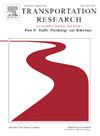Video-based hazard prediction and perception tests for Chinese motorcyclists and their associations with crash involvement
IF 3.5
2区 工程技术
Q1 PSYCHOLOGY, APPLIED
Transportation Research Part F-Traffic Psychology and Behaviour
Pub Date : 2025-02-01
DOI:10.1016/j.trf.2025.01.040
引用次数: 0
Abstract
Introduction
Hazard perception, which is closely related to crash involvement, is the ability to anticipate potential hazards on road. However, because of the lack of valid instruments, studies concerning the hazard perception of motorcycle riders and its associations with crash involvement are very limited in China. This study aims to develop a short hazard perception test and a short hazard prediction test using the response time method and hazard prediction paradigm, respectively.
Methods
This study presents 12 video clips, filmed from the motorcycle rider’s perspective, to experienced motorcycle riders (n = 48) and novice riders (n = 44). The hazard perception test requires a timed button-press response to the appearance of a hazard, whereas the hazard prediction test requires the participants to answer several questions after the clips are occluded right before the hazard unfolds.
Results
The hazard prediction test and the hazard perception test both involved 10 video clips with reliabilities of 0.75 and 0.61, respectively. Significant experience-related differences were found, with experienced motorcycle riders scoring higher on the hazard prediction test and responding to hazards faster than novice riders did. Age had no significant effect on the response times or the scores on the hazard prediction test because of the limited age range (19–34 years) of the motorcycle riders in this study. More important, motorcycle riders who had been involved in previous traffic crashes had lower scores on the hazard prediction test and longer response times to hazards than their peers who had not been involved in traffic crashes did, providing evidence for known-group validity (an instrument’s ability to distinguish among distinct groups).
Conclusion
The two short tests developed in this study have acceptable reliability and validity and are extremely useful tools for the assessment and classification of motorcycle riders in China.
求助全文
约1分钟内获得全文
求助全文
来源期刊
CiteScore
7.60
自引率
14.60%
发文量
239
审稿时长
71 days
期刊介绍:
Transportation Research Part F: Traffic Psychology and Behaviour focuses on the behavioural and psychological aspects of traffic and transport. The aim of the journal is to enhance theory development, improve the quality of empirical studies and to stimulate the application of research findings in practice. TRF provides a focus and a means of communication for the considerable amount of research activities that are now being carried out in this field. The journal provides a forum for transportation researchers, psychologists, ergonomists, engineers and policy-makers with an interest in traffic and transport psychology.

 求助内容:
求助内容: 应助结果提醒方式:
应助结果提醒方式:


